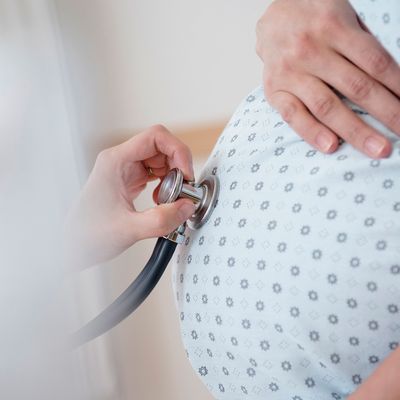
What can 200 pregnant women tell us about how many people already have the coronavirus or how sick they get?
Months into the pandemic, there’s so little definitive information about the virus — even the baseline question of how many people have it, where they live, and how they fare — that it’s no wonder people excitedly seize on any new data, however inconclusive, that might provide some insight. That’s what happened on April 13, when public figures started tweeting about a letter published in The New England Journal of Medicine.
The letter was fewer than 500 words long. It was a report from two New York City hospitals, both affiliated with New York–Presbyterian, that had tested all 215 patients admitted for delivery between March 22 and April 4. Only four, or about 2 percent, of those patients had any symptoms of the coronavirus, and all four tested positive. What was more surprising was that 29 women, or 13.7 percent of the total pool, tested positive without having any symptoms. (Three of them were reported to have a fever by the time they left the hospital a couple of days later.)
Former Obama health-care official Andy Slavitt, who has over 400,000 followers on Twitter, immediately declared that the takeaway is that 15 percent of New Yorkers may already have COVID-19. (He subsequently walked that back.) Scott Gottlieb, who ran the FDA until last year, also speculated that the data in the letter suggested “exposure in New York to COVID could be very high.”
How many people have already had or are currently infected with the coronavirus is both significant and elusive: It could tell us how close we are to possibly reaching herd immunity or give us a better baseline for how many of the infected actually become critically ill or die. If more people have had it than we think, the news could actually be good. The high numbers of asymptomatic patients could also indicate how many people get infected and have the ability to spread it without ever knowing — the so-called “silent spreaders.”
The problem is, testing in the U.S. has been a debacle for months; despite the acute need, Politico recently reported that the number of tests being analyzed by labs actually dropped by 30 percent in the last week. Some countries have been able to go further than testing current suspected cases by testing for antibodies that suggest someone may have had the disease and could even be immune to it now. Antibody tests have been promised in New York and across the country but so far are a rare commodity that could take months or years to perfect.
Another reason the data was greeted so eagerly is that New York’s hospitals have been ordered to stop all elective surgeries and the public has been told to avoid the hospital unless it’s a true emergency, making pregnant and laboring the only predictable flow of patients. And some New York City–area hospitals are only testing women with symptoms, which makes it hard to figure out how many people are asymptomatic.
“The differences between the test-positive rates that we’re seeing in a lot of different places is that they’re being screened for something specific — either they have symptoms or they have a close contact,” said Stephanie Gaw, a professor of maternal-fetal medicine at the University of California–San Francisco, who is co-leading the Priority study of pregnancy and the coronavirus. “This was not that. In that sense, it could be a snapshot of people walking around.” The Priority study already has over 200 participants from around the country.
But to be clear, this was a letter, reporting preliminary results that were less than ten days old, nothing approaching a peer-reviewed study despite the prestige of the outlet. The team at New York–Presbyterian wasn’t testing pregnant patients to draw sweeping conclusions about prevalence or asymptomatic transmission. They actually started testing everyone out of fear of infecting their medical workers. In mid-March, two women were admitted to the hospital for scheduled inductions of labor because of non-coronavirus-related complications; though neither had any symptoms when admitted, both became critically ill with COVID-19 soon afterward. Over a dozen medical staff were exposed to the virus without protective gear, according to the hospital, which led to the short-lived ban on companions in labor and delivery and the more lasting policy of testing everyone in labor. The initial data, the letter said, “underscores the risk of COVID-19 among asymptomatic obstetric patients.”
The study’s authors also never said their 215 women were remotely representative of the general population. They don’t disclose any of the pool’s demographics besides their pregnancy (and didn’t respond to an interview request). “Pregnant women are younger in general,” Gaw pointed out, whereas most of the worst-affected by the coronavirus are older men. There’s another problem with drawing conclusions from the data. “Pregnant women are very different physiologically than nonpregnant people,” Gaw said. “Your immune symptom is suppressed. And many diseases have different symptomology in pregnancy.” That could cut either way: “With many diseases when they’re diagnosed in pregnancy, most pregnant women don’t show signs but some may become more ill … To really compare, you’d have to compare to similar-age nonpregnant women to say there’s a significant difference.”
While the group of women described by the New England Journal of Medicine letter were mostly asymptomatic or had mild symptoms, others have become very sick, and not just the two women at New York–Presbyterian who prompted the system’s universal testing. At least two New York women, Precious Anderson and Yanira Soriano, were successfully delivered by C-section when they were unconscious because of being critically ill from the coronavirus but seem to have recovered. Their babies are so far reported to be doing well.
We also don’t know how pregnancy affected the study pool’s patterns of behavior leading up to the tests — were they likelier to stay home because of pregnancy? Or were they being seen by doctors weekly before their due dates, which might have raised their exposure? And even if it can be generalized, the data may only tell us about how prevalent the virus is in a pocket of New York City. Gaw said a handful of other hospitals have begun universal testing of patients admitted for labor and delivery, including the Kaiser Permanente system in California and Oregon Health and Sciences. The West Coast has so far seen lower rates of confirmed infection and deaths. One hospital in Stockholm, Sweden, where the government has conspicuously refused to lock down the population, reported on April 10 that when they tested all women in labor, only 7 percent were positive.
Unfortunately, past studies of theoretically similar diseases can only tell us so much. “The data from the other coronaviruses is very sparse,” says Gaw. “There were maybe 50 pregnant women [studied] from those outbreaks. The ones that they did report were barely ill. In general, it’s probably biased towards sicker patients.” As with so much of the coronavirus pandemic, we’ll just have to wait to know more.






























